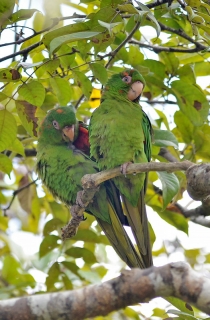Cuban Conure |
|
|
Also known as: Cuban Parakeet, Red-speckled Conure
Photos
View in GalleryDid You Know?
In the wild the Cuban Conure uses various sites for nesting, particularly Cuban Green Woodpecker (Xiphidiopicus percussus) cavities. This species also builds nests in termite mounds in trees.Programs & Projects
WPT has worked with numerous partners to help save this species. Learn moreAcademic Research
Related publications: Psittacara euopsSpecies Profile
Genus: Psittacara | Species: euops
Size:
26cm (10.1 in)
Weight:
90g (3.1 oz)
Subspecies including nominate:
one
Colour Adult:
Both adults yellow/green in general with red feathers sprinkled on head and underparts, sometimes with red feathers on bend of wing and thighs; red lesser underwing coverts and carpal edge; olive/yellow greater underwing coverts and underneath flight feathers. Bill horn coloured. Eye ring bare and pink/white. Eye pale yellow.
Colour Juvenile:
As in adult but red feathers on head and underparts absent; less red on underwing coverts; yellow/green carpal edge. Eye brown.
Call:
Calls are unique; in flight repetitious and loud. While perched notes are low and whispering.
Listen NowMore Information:
Content Sources:
CITES
BirdLife International
Cornell Lab of Ornithology/Birds of the World
A Guide to Parrots of the World, Juniper and Parr, 1998
ML Media Collection Catalogue 112182, Cuban Parakeet Aratinga euops, Budney, Gregory, Holguin, Cuba, Feb. 15 2004, Cornell Lab of Ornithology. Site
Parrots: Status Survey and Conservation Action Plan, Snyder, McGowan, Gilardi and Grajal, 2000.
Parrots of the World, Forshaw and Cooper, 1977. 2010 edition
Parrots of the World, Forshaw, 2006.
Lexicon of Parrots, Thomas Arndt.
Parrots in Aviculture, Low, 1992.
Photos
View in GalleryDid You Know?
In the wild the Cuban Conure uses various sites for nesting, particularly Cuban Green Woodpecker (Xiphidiopicus percussus) cavities. This species also builds nests in termite mounds in trees.Programs & Projects
WPT has worked with numerous partners to help save this species. Learn moreAcademic Research
Related publications: Psittacara euopsSpecies Care
Captive Status:
Rare
Longevity:
15-40 yrs
Housing:
Enclosure or suspended aviary, minimum length 2m (6.5 ft).
Diet:
Fruit such as: apple, pear, orange, banana, cactus fruits, pomegranate, forming about 30 percent of the diet; vegetables such as: carrot, celery, green beans, peas in the pod; fresh corn; green leaves such as: Swiss chard, lettuce, sowthistle, dandelion; spray millet; small seed mix such as: canary, millet, safflower, oats and limited hemp; soaked and sprouted sunflower seed; cooked beans and pulses; boiled maize; complete kibble.
Enrichment:
Provide fresh, unsprayed bird-safe branches for chewing and bowls of fresh water for bathing.
Nest Box Size:
Vertical box 7" x 7" x 28" (17.8cm x 17.8cm x 71cm).
Clutch Size:
4-5
Incubation Time:
23-26 days
Fledging Age:
48-60 days
Hatch Weight:
Not recorded.
Peak Weight:
Not recorded.
Weaning Weight:
Not recorded.
Photos
View in GalleryDid You Know?
In the wild the Cuban Conure uses various sites for nesting, particularly Cuban Green Woodpecker (Xiphidiopicus percussus) cavities. This species also builds nests in termite mounds in trees.Programs & Projects
WPT has worked with numerous partners to help save this species. Learn moreAcademic Research
Related publications: Psittacara euopsSpecies Wild Status
World Population:
2500-10,000
IUCN Red List Status:
Vulnerable
CITES Listing:
Appendix II
Threat Summary:
This species is affected by habitat loss and heavy trapping, particularly of juveniles, for the wild bird trade. The most significant reason for loss of nesting sites is hurricane damage. Most of the remaining wild populations have some protection within the Protected Areas System of Cuba (SNAP) and numerous Important Bird Conservation Areas (IBAS).
Range:
Found in Cuba and formerly Isla de la Juventud (Isle of Pines), West Indies.
Habitat:
Found in areas of savanna where Copernica and Thrinax palms occur, woodland edge and agriculture areas with trees.
Wild Diet:
Feeds on fruits of mango, papaya, guava, Zanthoxylum martiniscense, Sapium jamaicense and Cecropia schreberiana, green and ripe fruits of Manguifera indica, Roystonea palms, Melicoccus bijugatus and Spondias luteus, majagua flowers, Talipariti elatum and Gliricidia sepium, fruits of jobo Spondias mombin and seeds of Inga vera, shoots, millet, berries and grass seeds. Also fruits and seeds of mamoncillo Melicocca bijuga and úcaro Bucida buceras, guásima Guazuma ulmifolia, flowers and flower buds of the bucaro tree Erythrina poeppigiana, fruit and seeds of orange trees Citrus sinensis fruits and seeds of Cecropia schreberiana, and fruits of Spondias mombin.
Ecology and Behaviour:
Seen generally in family groups or small flocks but sometimes gather in larger congregations of several hundred. Will socialize with the Cuban Amazon. Nests in hollow palm, tree-cavity or active arboreal termite nests.
Clutch and Egg Size:
4-5 rounded eggs, 27.5 x 22.0mm (1.0 x 0.9 in)
Breeding Season:
May-July. Nest is in tree cavity.
Related Links:
Photos
View in GalleryDid You Know?
In the wild the Cuban Conure uses various sites for nesting, particularly Cuban Green Woodpecker (Xiphidiopicus percussus) cavities. This species also builds nests in termite mounds in trees.Programs & Projects
WPT has worked with numerous partners to help save this species. Learn moreAcademic Research
Related publications: Psittacara euopsMembers Only Resources
Please log-in now to find more research, resources and tools.
Not a Member?
Find more great information:
Gain exclusive access to 600+ pages of additional research, seminars and podcasts, specialists to ask your toughest questions, and dozens of other fun resources - when you become a WPT member.
Join Today >>

































